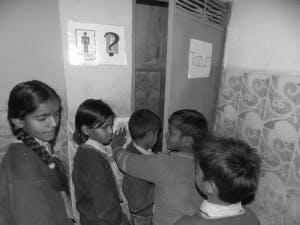A Beautiful Gift Called Education
Dec 19, 2017
Story


It is 4.30 in the morning. Dimple,11, gets up to clean her house,situated in a village just outside Delhi. She then goes on to prepare food for her family, feeds her 7 year old brother,and with drowsy eyes, makes her way to the local school. Both her parents work as laborers in Delhi. She knows that it is matter of time before her mother would force her to drop out of school, to work with them on the fields.
Not very far from Delhi, in the state of Rajasthan, lives 15 year-old Janvi. She attends school and harbors a secret dream of joining the Police Force. But soon she will be married off to a man, almost thrice her age, and forced to live a life of domestic servitude.
Despite the tall claims by the Government and efforts made under the Right To Education Act, reports have shown that a shocking 53% of girls have failed to enroll in schools.Though we have made considerable progress in terms of literacy rate, access to girls' education still remains an uphill task.
Education for me has been more than reading and writing.I have valued it as a gift,since childhood. But for millions of girls in India, this was not the case. For many acquiring education remained a distant dream.
Barriers:
In a culturally diverse country like India, there are inter related and socially constructed gender disparity factors that contribute in prohibiting girls' access to education. Below are listed the most important ones:
Cultural : World Bank economists have noticed that economies "that have a preference for not investing in girls pay a price for it in terms of slower growth and reduced income." India is a shining example of this. Girls here are considered as " Paraya Dhan ". In English it means - other's property. Girls are viewed as liabilities, wherein post marriage, they are expected to concentrate on household chores, tasks for which education is deemed unnecessary.
Child marriage: Though illegal under law, more than 40% of world's child marriages happen in India. This social evil has forced many young girls to drop out of schools. It has denied them of their childhood, increased the risk of abuse and jeopardized their health. Parents, in the hope of ensuring their daughters do not involve in pre-marital sex, have found child marriage to be an easy way to fix this.
Sanitation facilities: Hygienic parameters need to be considered, when discussing the high drop out rate of girls from schools. There have been reports that link girls' attendance rates to their menstrual cycles and sanitation facilities available at schools.Inadequate facilities like non availability of separate toilets or absence of clean water supply,leads to absenteeism and high drop outs especially in the age group of 9-14 years.
Economic : In India,families with low economic opportunities, cannot cope if their children do not work. Girls are invariably the first to be withdrawn from schools if money is short or if household needs attention.
Security threat: For many girls, especially in villages,absence from school is also related to safety. Sometimes girls risk being abducted or raped on the often long way to school.
Gender Disparity at work : Mostly in developing countries, women earn less than men even if they have the same education and experience.In India,economic returns are better for boys than girls, which makes parents unfavorable to support girls ' education.
Unfortunately the barriers are many but there is no single solution to tackle it. Improved social, economical and political mindset is required to better the situation.
Firstly the schools and homes need to be gender sensitized. We require more women teachers who can handle girls' issues and act as role models.
Building of separate toilets at public schools will encourage the girls to stay longer and complete her education.
Change in social attitude alone, cannot bridge the gap. Even the labor market need to address the issue of equal pay effectively. Nationalized Banks can come forward and assist in low interest loans to families looking for their daughters' education.
With campaigns on TV and plays in schools and village level, we can highlight the benefits of girls' education on a larger scale. The evils of child marriage, child labor and dowry needs to be shown the door.
Equal access to education forms the foundation for eradicating poverty,combating disease and ensuring sustainable growth. By keeping our daughters uneducated, we are missing out on one half of the potential workforce.
We need to understand that the gift of education is for all. By promoting girls' education,we are increasing the chances of a happier and healthier present and a brighter future generation.
"Educating girls is not an option, it is a necessity"- Kofi Annan.
P.S. I have attached a link to a video by HEEALS which highlight the sanitation problems girls face in India. Do watch it !




